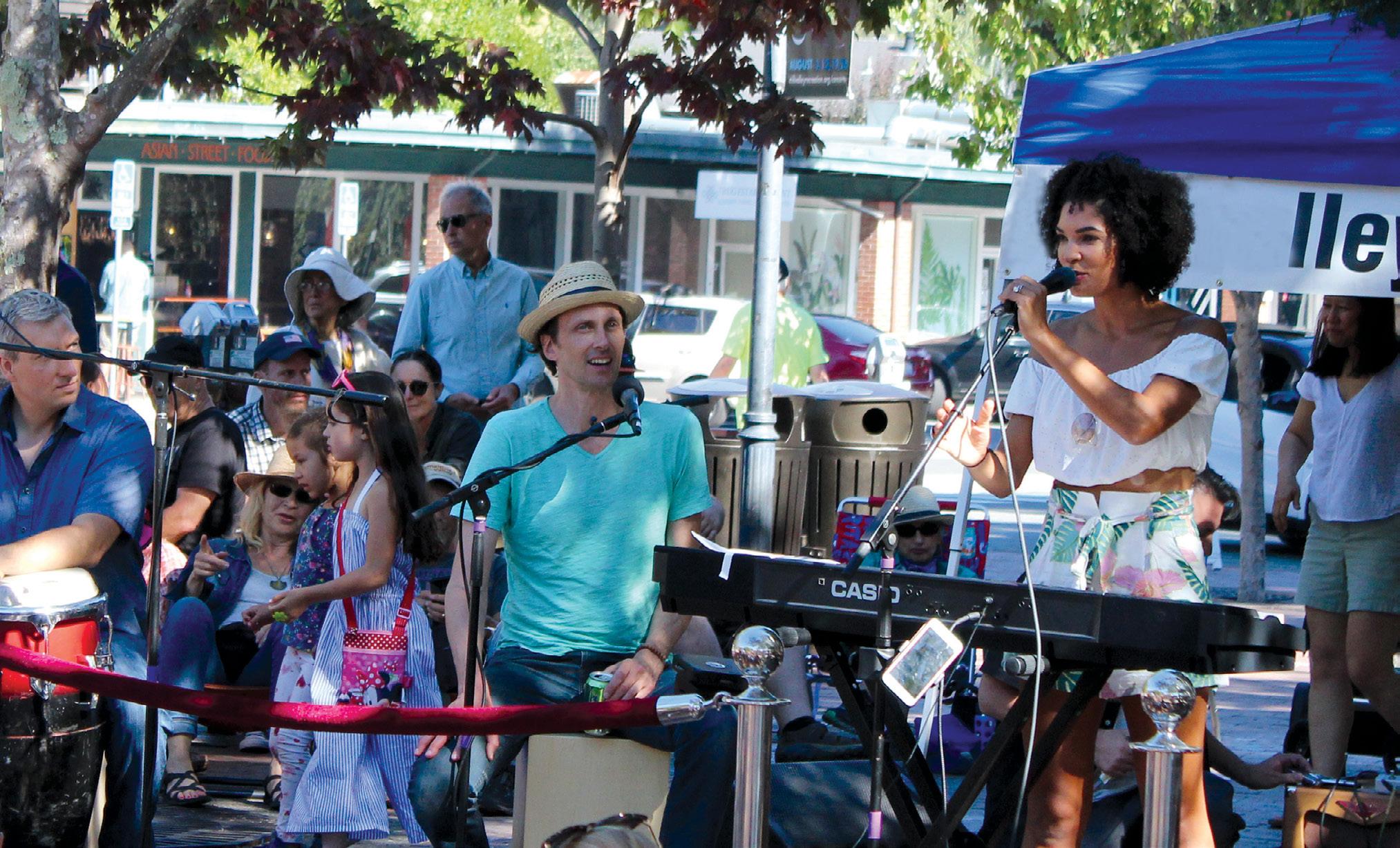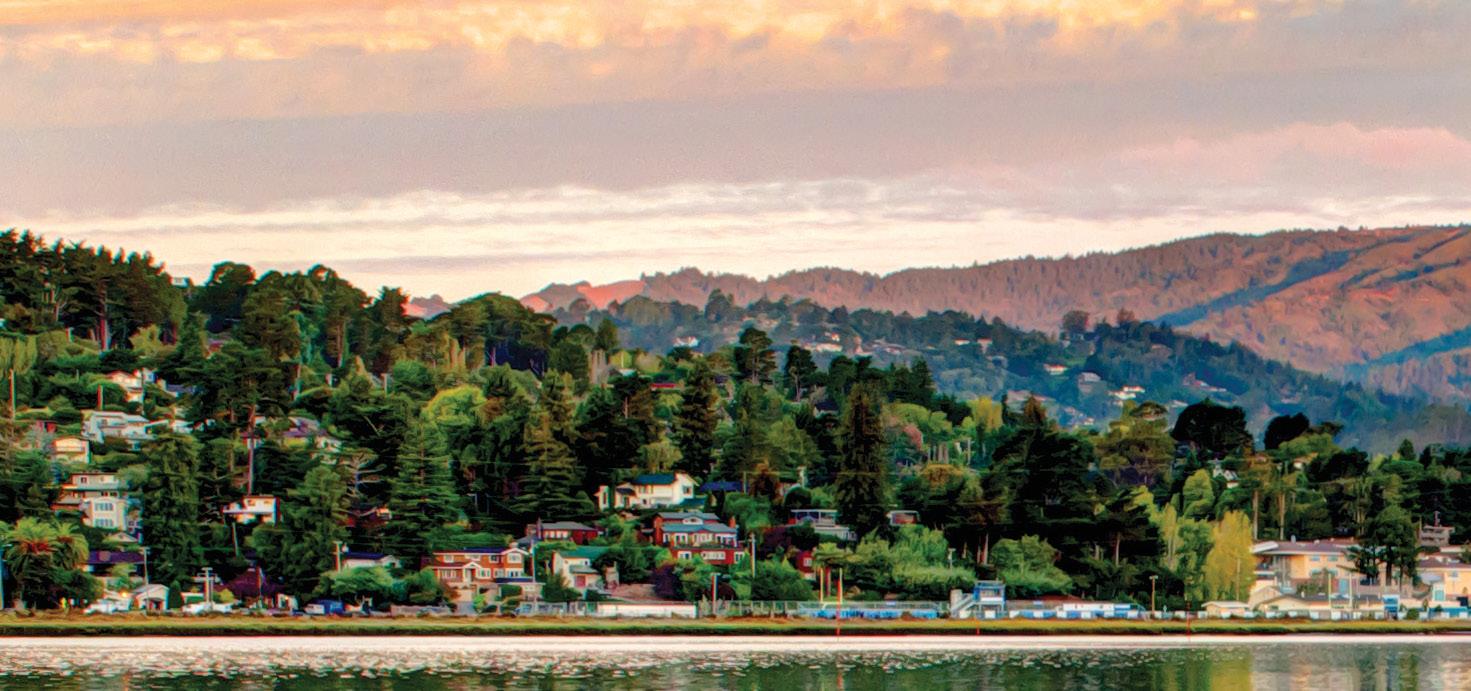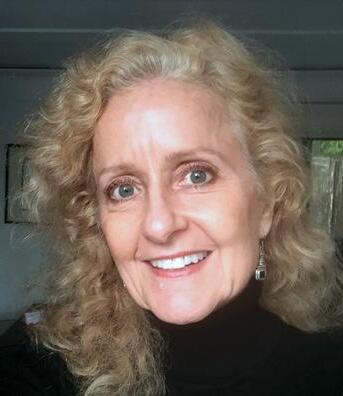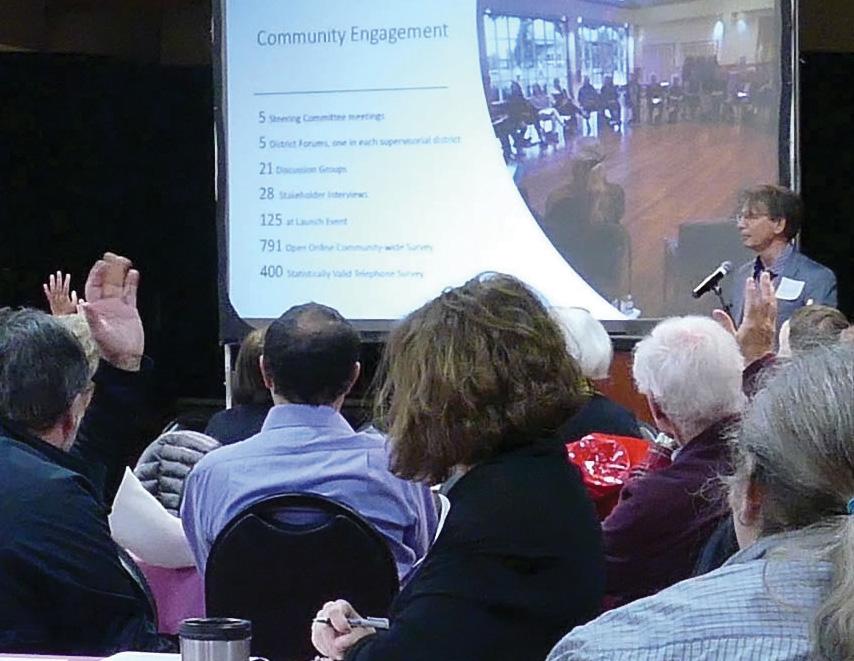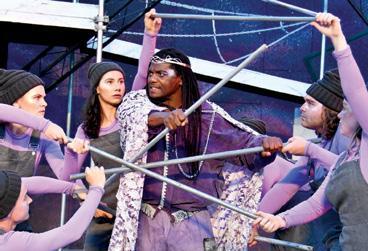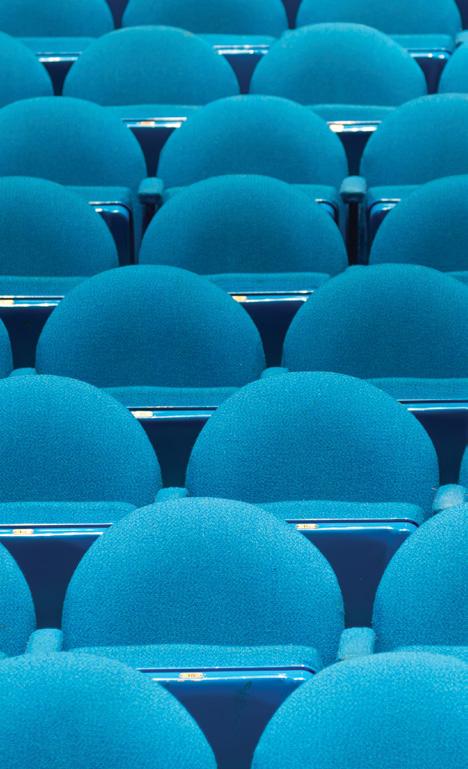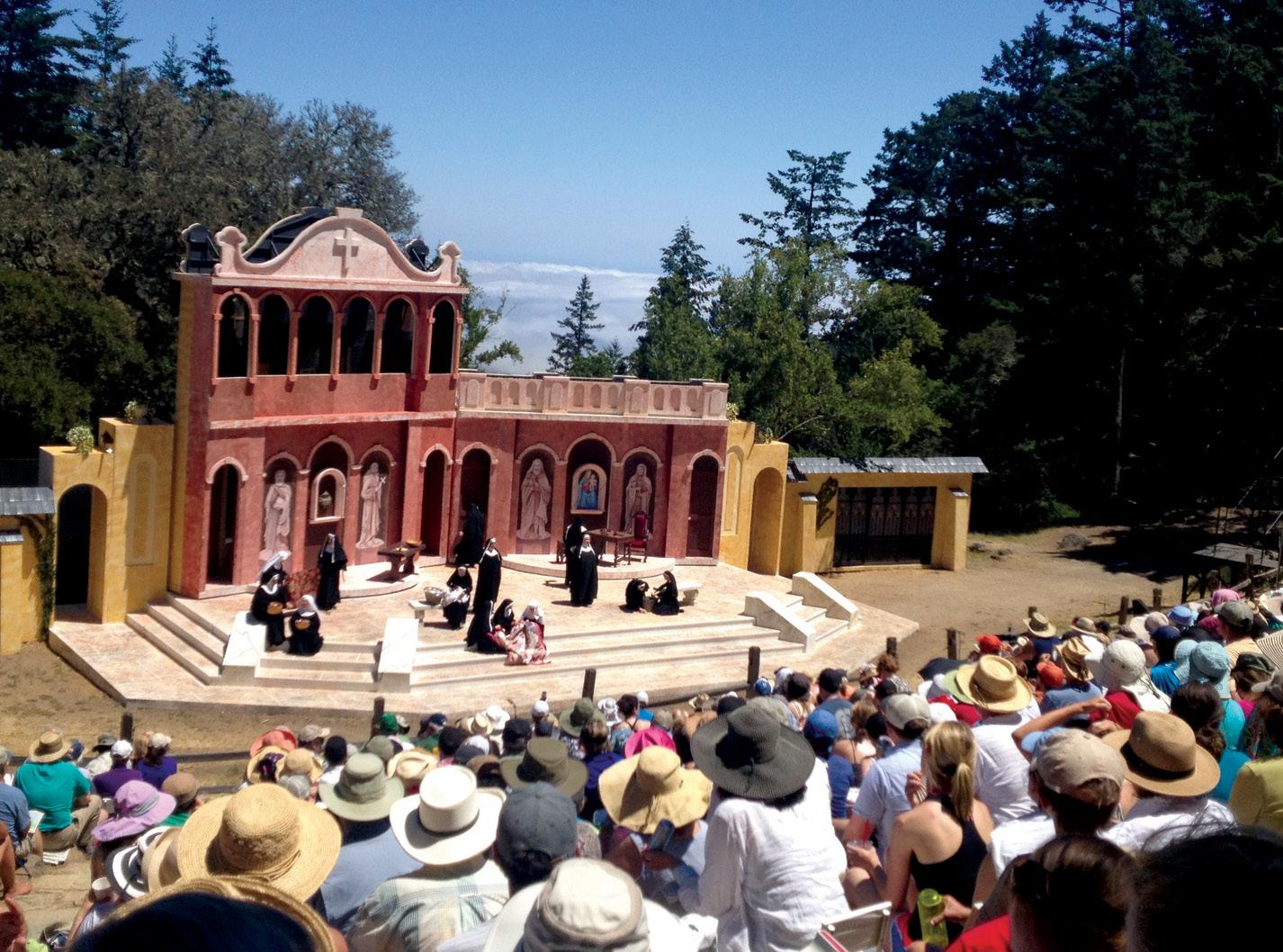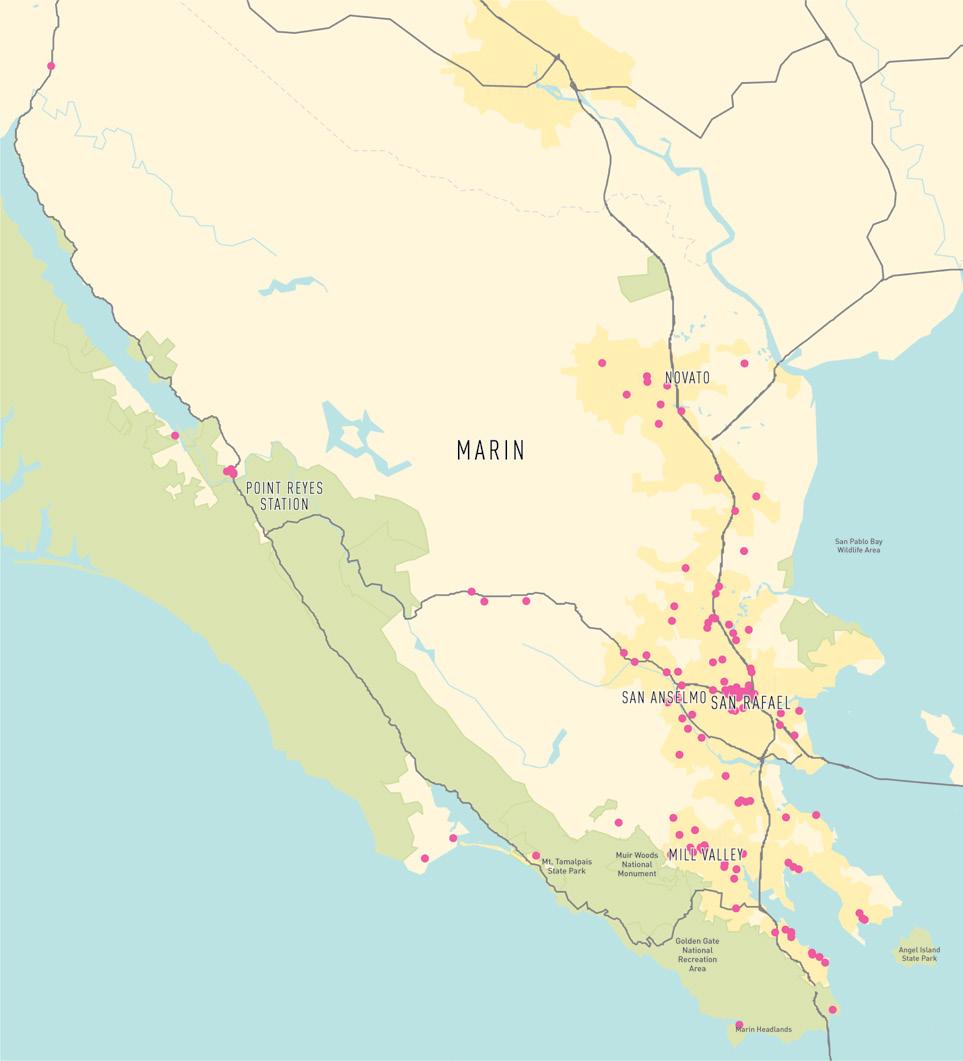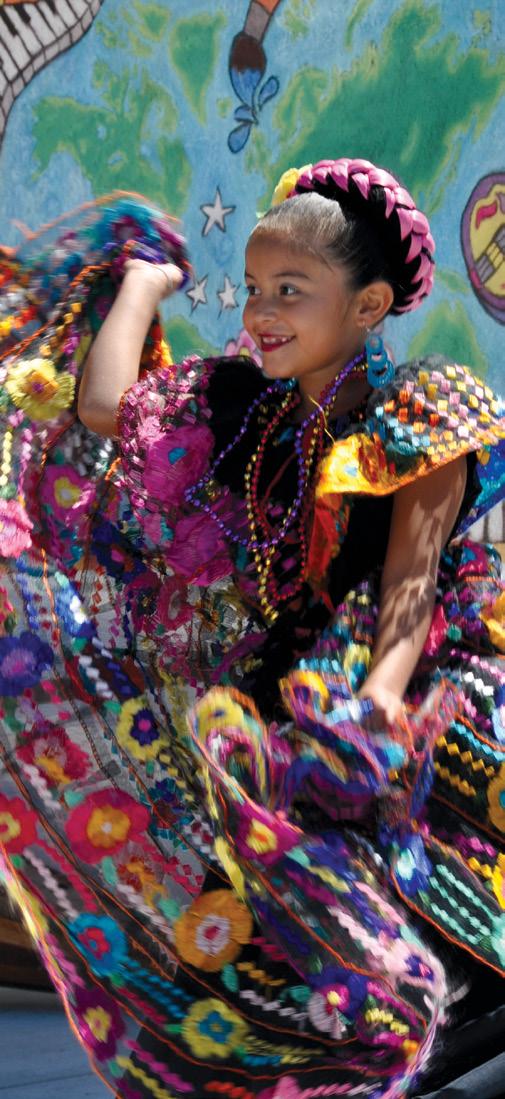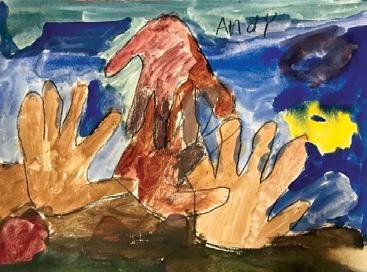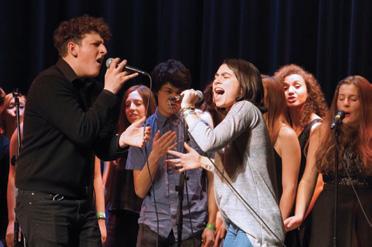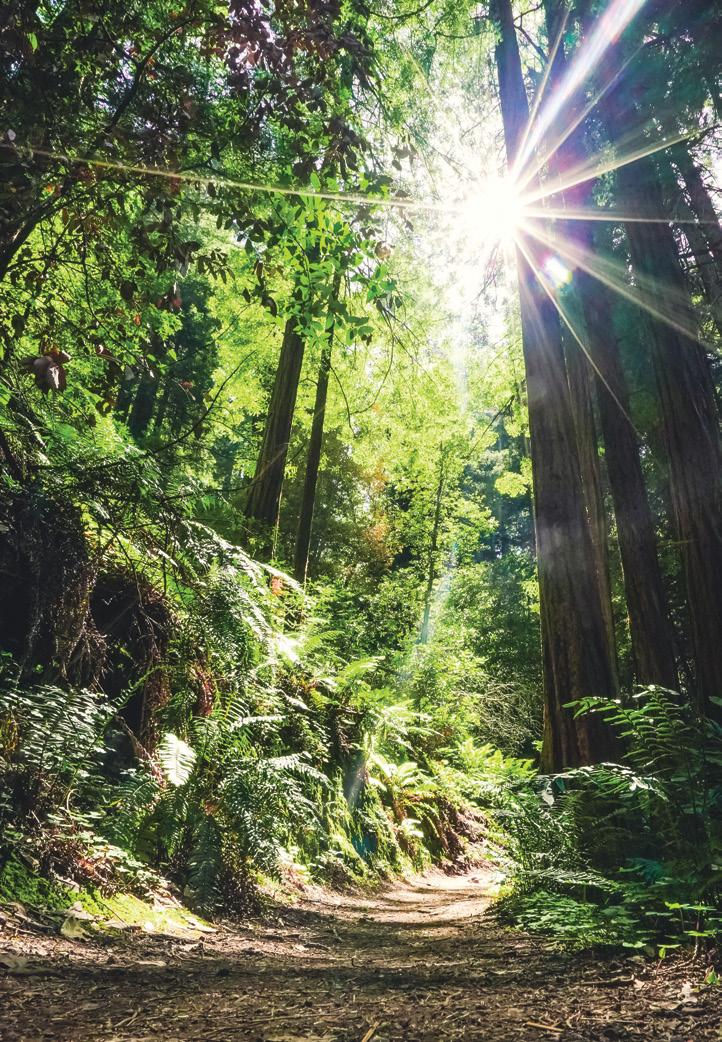COVER PHOTOS: (STARTING TOP LEFT, CLOCKWISE): YOUTH IN ARTS, MARIN CENTER EXHIBITION, MILL VALLEY CONCERT IN THE PLAZA, MARIN CENTER - LOBBY LOUNGE, MARIN CENTER EXHIBITION, SMITH RAFAEL FILM CENTER
BEAUTY DIVERSITY TRANSFORMATION SPIRIT
INTRODUCTION
Dear Friends,
I am pleased to introduce ARTS CULTURE ACTION MARIN!, a comprehensive cultural plan for Marin County. This is a plan that sees the arts and culture as a true cornerstone of Marin’s identity and pride.
As a long-time resident of southern Marin, I am keenly aware of the bounty of arts and culture that surrounds us. From live music of all kinds, “plein air” painting along our streets and open spaces, and dance in our schools and town squares, to poetry readings and literary events, we have a lively scene. That scene, and the artists and creative individuals who make it happen, are increasingly under pressure as the cost of living and housing in Marin steadily increases. To protect what we cherish and value, we were called to take action and begin a community-wide conversation about how best to support Marin’s identity as a home to arts and culture, and the people and organizations that make it happen.
In 2016, Gabriella Calicchio, Director of Cultural Services for Marin County, teamed up with Marin resident and arts activist, Tammy Edmonson, to explore the development of a cultural plan for Marin. With widespread community support and a Steering Committee of diverse community and business leaders, a countywide cultural planning effort was launched in September 2018. The inclusive, sixmonth process involved dozens of public planning forums, interviews, surveys, data collection and analysis. This effort has reconfirmed that arts and culture are critical components in shaping Marin’s identity, both enriching our lives and fueling our local economy. At the same time, the inquiry identified economic and organizational threats to the health of our creative sector and reminded us that the benefits of ready access to arts and culture remain out of reach for many Marin County residents.
As a member of the Steering Committee, I have been thrilled to see Marin residents show up and speak out in large numbers to advocate for creating a shared vision of Marin’s artistic future. I am proud of our community’s deep commitment to ensuring that the County’s artistic and cultural resources not only thrive but also benefit every resident, and willingness to embrace the challenge of securing the necessary financial support to achieve those goals.
ARTS CULTURE ACTION
MARIN! is an ambitious but achievable plan to address these challenges and to grow support and recognition for Marin arts and culture. I look forward to continuing this collaborative effort to ensure that all Marin residents, and the arts and culture community that sustains us, flourish now and in the future.
Best regards,
MARIN COUNTY BOARD OF SUPERVISORS
ARTS CULTURE ACTION MARIN! STEERING COMMITTEE
Laura Bradley Davis | Principal LBD CONSULTING
Tod Brody | Executive Director
MARIN SYMPHONY
Gabriella Calicchio
Director | MARIN DEPARTMENT OF CULTURAL SERVICES
Executive Director | MARIN CULTURAL ASSOCIATION
Lesley Currier | Managing Director MARIN SHAKESPEARE COMPANY
Tammy Edmonson | Communication Coordinator
MARIN COALITION FOR THE ARTS
Mark Essman | President MARIN CONVENTION AND VISITORS BUREAU
Kathleen Gaines | Marketing & Development Director MARINARTS
Felicia Gaston | Executive Director
PERFORMING STARS OF MARIN
Don Jen | Director for Education
MARIN COMMUNITY FOUNDATION
Jane Kramer | Executive Director
ENRICHING LIVES THROUGH MUSIC
CONSULTANTS
David Plettner-Saunders | Managing Partner
Jerry Allen | Partner
Linda Flynn | Partner & Research Director
Miko Lee | Executive Director YOUTH IN ARTS
Marialidia Marcotulli | Board Member MARINARTS
Oshalla Diana Marcus | Executive Director MC ARTS AND CULTURE
Sara Matson | Development Director CANAL ALLIANCE
Danielle O’Leary | Director ECONOMIC DEVELOPMENT DEPARTMENT
CITY OF SAN RAFAEL
Suzie Pollak | Vice Chair
MARIN CULTURAL ASSOCIATION
Jenny Rogers | Director
MILL VALLEY RECREATION DEPARTMENT
Sirima Sataman | Executive Director WEST MARIN WORKSHOP
Donna Seager Liberatore | Owner SEAGER GRAY GALLERY
Kathrin Sears | Marin County District 3 Supervisor COUNTY OF MARIN
ACKNOWLEDGEMENTS
MARIN COUNTY BOARD OF SUPERVISORS
Damon Connolly | District 1
Katie Rice | District 2
Kathrin Sears | District 3
Dennis Rodoni | District 4
Judy Arnold | District 5
MARIN CULTURAL ASSOCIATION BOARD OF DIRECTORS
MARIN COUNTY CULTURAL SERVICES COMMISSION
The plan was adopted by the Marin County Board of Supervisors on May 14, 2019.
Elisabeth Setten | Executive Director ART WORKS DOWNTOWN INC
Lynn Sondag
Chair | Department of Art, Art History, and Design DOMINICAN UNIVERSITY
Robin Sternberg | CEO
MARIN ECONOMIC FORUM
Chantel Walker | Assistant Director
MARIN COUNTY FREE LIBRARY
STAFF
Libby Garrison
Tierney Hamilton
Tea Francesca Price
MARIN COMMUNITY FOUNDATION
WILLIAM AND FLORA HEWLETT FOUNDATION
CALIFORNIA ARTS COUNCIL
WILHELM FAMILY FOUNDATION
COUNTY OF MARIN
COUNTY OF MARIN INFORMATION SERVICES AND TECHNOLOGY
MARIN’S PATH TO A CULTURAL PLAN
AN OVERVIEW BY CO-LEADERS OF THE PLANNING PROCESS, GABRIELLA CALICCHIO AND TAMMY EDMONSON
SINCE WELL BEFORE THE BRIDGES SPANNED THE BAY, Marin County has drawn and spawned a rich concentration of creative talent: painters and poets, musicians and filmmakers, actors, writers, dancers, comedians — innovators of every discipline. And so our community has long enjoyed an artistic abundance that unites us in shared experiences, fuels our capacity for wonder and invention, and stimulates our local economies. Informed by this history, it is easy to suppose that Marin’s creative sector will forever bloom if left to its own devices. But in a world of change, how healthy is Marin’s creative landscape, and what role might our community play in shaping and securing its own creative future? When Supervisor Kate Sears introduced the two of us in 2016, she knew these questions were looming in both of our minds.
Soon after that introduction, we invited arts leaders from throughout the County to join us, under the banner of MARIN COALITION FOR THE ARTS, to share their perspectives on the state of the arts in Marin. Over the course of a year, a portrait emerged of a creative sector that — while broad and colorful — is nevertheless struggling and shrinking due to Marin’s high cost of living, declining philanthropic support, and a lack of coordinated arts leadership. Marin arts nonprofits, we learned, increasingly face a choice to cut programming or close their doors. Diminishing performance and exhibit opportunities squeeze our remaining resident artists, who continue to leave the County in large numbers in search of affordable, arts-friendly communities. Marin’s low income communities and communities of color — that have never been equitably reflected or served within the creative sector — face deepening challenges. Although it is part of the State-mandated curriculum, arts education in the County’s 18 public school districts is widely variable and, in some cases, virtually nonexistent.
The Coalition’s consensus: Marin can no longer afford to leave its endangered arts resources to chance; we must plan and work together for the creative future that we want.
Propelled by this mandate, we worked with MARIN CULTURAL ASSOCIATION — a nonprofit under the umbrella of the MARIN DEPARTMENT OF CULTURAL SERVICES — to obtain grant funding and employ the expert CULTURAL PLANNING GROUP to lead the development of a comprehensive arts and culture master plan for Marin.
In September 2018, a Steering Committee made up of Marin community and business leaders launched the public planning process known as ARTS CULTURE ACTION MARIN!. The six-month process engaged more than 1,700 Marin residents through interviews, surveys, and dozens of community forums aimed at identifying the community’s unique values, goals, and priorities in the arts arena. To ensure that the plan would be well-informed and data driven, our team conducted unprecedented research charting the size, shape and economic impact of Marin’s existing creative sector. This included an inventory and map of approximately 1,750 Marin arts businesses and nonprofits, and an AMERICANS FOR THE ARTS study documenting the $76.4 million dollar annual contribution of Marin arts nonprofits to our economy.
The robust goals of the resulting plan are carefully tailored to Marin’s own creative landscape, and to the needs and values articulated by this community around its three overarching aims: raising the profile and visibility of the arts in Marin; ensuring that the benefits of the arts flow to every member of our community; and working collaboratively to sustain Marin’s artistic resources.
We are inspired by the enthusiasm of this community, and grateful to everyone who invested their time and talent to help chart a path for the future of the arts in Marin County. We appreciate the leadership of our Board of Supervisors whose members hosted planning forums in each of their districts, and we especially want to thank Supervisor Sears for her service on the Steering Committee, and for making the introduction that sparked this effort. We look forward to continuing our work together on the plan’s implementation for an ever more creative Marin.
Gabriella Calicchio | Director
MARIN DEPARTMENT OF CULTURAL SERVICES
Tammy Edmonson
COMMUNITY ARTS ADVOCATE
BENEFITS OF THE ARTS
ARTS STRENGTHEN THE ECONOMY
The arts represent a larger share of the nation’s economy – 4.2% of GDP – than transportation, tourism, and agriculture (source: US Bureau of Economic Analysis)
%
AN OVERWHELMING MAJORITY
OF MARIN’S RESIDENTS value the arts for their own sake — 94%. But 91% also consider them important to the community. What are these benefits? Why do the arts matter?1
ARTS DRIVE TOURISM & REVENUE TO LOCAL BUSINESSES
Attendees at nonprofit arts events spend $31.47 per person, per event, beyond the cost of admission on items such as meals, parking and babysitters — valuable commerce for local businesses. One-third come from outside the county in which the arts event takes place, and these visitors average $47.57 in event-related spending. Arts travelers are ideal tourists, staying longer and spending more to seek out authentic cultural experiences.
ARTS HAVE SOCIAL IMPACT
UNIVERSITY OF PENNSYLVANIA researchers have demonstrated that a high concentration of the arts in a city leads to higher civic engagement, more social cohesion, higher child welfare, and lower poverty rates.
ARTS SPARK CREATIVITY & INNOVATION
Creativity is among the top five applied skills sought by business leaders, per the Conference Board’s Ready to Innovate report – with 72% saying creativity is of high importance when hiring.
ARTS IMPROVE ACADEMIC PERFORMANCE
Students engaged in arts learning have higher GPAs, standardized test scores, and attendance, and lower drop-out rates. These academic benefits are reaped by students regardless of socio-economic status. Yet, the US Department of Education reports that access to arts education for students of color is significantly lower than for their white peers.
ARTS UNIFY COMMUNITIES
67% of Americans believe “the arts unify our communities regardless of age, race, and ethnicity” and 62% agree that “the arts help me understand other cultures better” – a perspective observed across all demographic and economic categories.
ARTS IMPROVE HEALTHCARE
Nearly one-half of the nation’s healthcare institutions provide arts programming for patients, families, and even staff. 78% deliver those programs because of their healing benefits to patients – shorter hospital stays, better pain management, less medication, shorter recuperation time, and reduced depression.
1 Source: Adapted from TEN REASONS TO SUPPORT THE ARTS, AMERICANS FOR THE ARTS, 2018, https://blog. americansforthearts.org/2018/03/09/ten-reasons-tosupport-the-arts-in-2018
HOW WE DID IT
THE CONTEXT FOR PLANNING CURRENT CONDITIONS
MARIN’S CURRENT CULTURAL ENVIRONMENT
From the bayside estuaries to the wild ocean beaches, Marin encompasses a collection of large and small communities nestled among abundant forests, parklands and open spaces. Artists and adventurers are powerfully drawn to create and explore amid this natural bounty. Accordingly, the County has historically enjoyed a rich artistic presence. Currently, that includes about 1,750 arts businesses and nonprofits, and a full spectrum of performing, visual, literary, digital, and other creative artists. Marin’s resident artists include many national and international icons in their fields, though the great majority of working artists in the County are lesser known.
Locals take great pride and enjoyment in the County’s artistic richness. The community survey demonstrates that over 90% of Marin residents consider the arts to be important to their own lives and to the Marin community. And yet, few residents — or visitors for that matter — have any idea of the true size, scope and quality of Marin’s arts sector. This is due, at least in part, to the absence of coordinated marketing and promotion of the sector. The County itself, and its large and growing tourist industry, have tended to focus their branding and marketing efforts on Marin’s environmental resources and recreational opportunities, and not the richness of its creative sector. The community’s limited awareness of arts
opportunities contributes to the difficulty artists and arts organizations face in attracting needed audiences, patrons and supporters.
The Marin arts audience includes many sophisticated attendees, with access to and experience with the arts in the Bay Area and other cultural capitals. The County’s arts sector offers a fair amount of programming of national or international stature, innovation, and contemporary interest. Still, a large number of residents (48%) say they go outside of Marin County for a majority of their arts, cultural and creative events and activities. In addition to the lack of information and the lure of other Bay Area arts offerings, distance and geography play a role in inhibiting local arts participation; many residents live in widely-dispersed smaller communities with limited public transportation.
Arts organizations struggling to sustain their programming in the face of declining audiences at times fall back on “safe” programming geared toward Marin’s majority, white, affluent and aging population, and toward more conventional interests and tastes. In turn, this inhibits participation by the County’s younger and more diverse populations, contributing to a growing perception that Marin’s artistic offering is mainstream and the County’s artistic identity is either unknown or unremarkable.
The County’s ever-increasing affluence and attendant high cost of living,2 further diminish
the diversity of the community and of the creative environment. Artists and innovators are leaving the County to pursue art in a more affordable and conducive environment.
The open community survey revealed artists’ top needs for sustaining their careers within the County are (1) more exhibition, performance, and sales/work opportunities in Marin, (2) affordable work space and/or live/work space, (3) more networking and connection opportunities with other Marin County artists, (4) professional development assistance, and (5) opportunities for leadership in the community (e.g., serving on boards or committees, advising organizations, working in social practice).
The lack of affordable performance and exhibit space is a leading concern for arts organizations as well. A few organizations own their own facilities. For other nonprofits, the Veterans’ Memorial Auditorium provides subsidized rentals, but these rates remain beyond the reach of many, and availability of spaces suitable for specific performing and exhibition needs is limited.
The high cost to artists and arts organizations remaining in Marin is more difficult to bear due to insufficient and declining arts funding, and a lack of coordinated arts leadership in the County. These issues are addressed under “County Leadership and Support for the Arts,” below.
MARIN COUNTY PARKS | SPIRIT NEST
COMMUNITY ACCESS TO ARTS
Considerable inequities exist for Marin’s diverse populations, including low income communities, indigenous peoples, and people of color. The gap between whites and people of color in Marin is greater than in any other California county across a range of measures, including economic opportunity, housing, crime and justice, health access, education, democracy, and a healthy built environment.3
Areas of particular concern include: inequities in arts education, both in and out of school; the fact that available arts offerings do not adequately reflect or serve the County’s diverse populations; and the disparate burden borne by poor and minority communities from the shortage of arts
funding, and of performance and exhibit space. These underserved residents are concentrated in geographically isolated areas with limited transportation to most arts venues and events. Many face added hurdles of language and cultural differences. There is a community of capable but under-resourced organizations providing arts programming in underserved communities and select arts organizations are working to diversify audiences and expand engagement, but progress is challenging.
Arts education is widely disparate in the County’s 18 school districts. Where available, it is often funded and provided by private organizations, not the districts. There are no visual and performing arts (VAPA) coordinators coordinators on staff in Marin school districts, a key element of providing quality arts education that is accessible to all.
The community survey confirmed what was evident in the community forums: Marin residents share a deep concern over the inequities that exist in their community. 85% of respondents placed a high importance on providing arts access to all residents and families; and 80% placed a high importance on recognizing and supporting Marin’s diverse communities in the arts.
COUNTY LEADERSHIP AND SUPPORT FOR THE ARTS
The current countywide general plan (2007) includes a range of goals for arts and culture, demonstrating the importance of the arts sector to the County vision. These goals and their supporting policies touch on some of the same issues that emerged in this planning process: increasing support for local artists and arts organizations, expanding
MARIN COUNTY FAIR
revenue streams, and installing public art (Goal ART-1); ensuring equitable access to the arts for all members of the community (Goal ART-2); and enhancing the Marin Center (Goal Art-3). Of these goals, only the third — enhancing the Marin Center — appears to have been assigned to a responsible government agency (the Department of Cultural Services) and to have advanced meaningfully in the past decade.
The Department of Cultural Services manages the Marin Center, produces the County Fair, and provides select County programming, but historically has not provided leadership or support for the broader arts community. Current County arts spending of $1.6 million focuses on the Marin Center, which is available for rental by nonprofit (and other) users of the Veterans’ Memorial Auditorium and Showcase Theater. The County also directs a small amount of its Community Grants (approximately $35,000 per year) to arts organizations. Beyond this, the County historically has left arts nonprofits, individual artists and creatives to their own devices.
Except for the County supported Marin Center, Marin’s creative sector faces a distinct shortage of institutional funding from foundations and corporations as well as from local government. In 2010 the MARIN COMMUNITY FOUNDATION eliminated its discretionary arts giving program and refocused on grants for education and social justice, some of which go to arts organizations. This represented a structural change in funding for many arts organizations, including the Marin Arts Council, which had relied on annual Marin Community Foundation grants to sustain itself and its own
program of grants to local arts organizations. Loss of these funds led the Council to dissolve in 2012. While individual giving remains strong, Marin’s arts community continues to struggle to adapt to the new funding environment.
A large majority of Marin residents say they would like to see the County provide financial support for the arts in their community. While few are fully aware of the County’s role in supporting arts at the Marin Center, ninety-one percent (91%) of survey respondent believe is it important that Marin County government financially support quality of life initiatives such as arts, cultural and creative activities in Marin County. Arts education, equitable access to the arts for all, and youth programming outside of school are among the community’s top priorities for arts investment.
Currently, the County has no public art program and only a couple of cities within its borders have undertaken public art programs. Yet, there is strong interest in more visible public art throughout the County — permanent, temporary, and interactive — with 69% of survey respondents stating creating more public art is a priority.
In conclusion, Marin’s cultural heritage and active arts ecosystem, while abounding with arts organizations and artists, faces significant systemic challenges to its preservation and future development. This plan continues the dialogue with the community about how Marin grows and changes and preserves all that is treasured.
3 www.racecounts.org/county/marin
4 Some Marin arts organizations receive funding from the California Arts Council and/or the National Endowment for the Arts, but this represents only a small percentage of total arts budgets.
Dameion Brown, who spent 23 years in prison, won the Bay Area Theatre Circle Critics award for “Best Actor” for his portrayal of Othello. When he’s not onstage, he works with Marin Shakespeare Company to teach Shakespeare in two youth correctional facilities. The company is also home to the Returned Citizens Theatre Troupe, formerly incarcerated actors who tell autobiographical stories through theatre.
MARIN BRIGHT LIGHTS
Marin Shakespeare
MARIN SHAKESPEARE
“THE ARTS ARE A BUSINESS –NOT A CHARITY.”
Robert Lynch | President & CEO
AMERICANS FOR THE ARTS
DEPARTMENT OF CULTURAL SERVICES
TOTAL ECONOMIC IMPACT LOCAL GOVERNMENT REVENUE STATE GOVERNMENT REVENUE
1,648
$76.4 $2
$5.6
million
Marin’s nonprofit arts and culture sector is a significant industry in Marin County — one that generated $76.4 million in total economic activity in 2018. This spending — $49.7 million by nonprofit arts and cultural organizations and an additional $26.6 million in event-related spending by their audiences — supports 1,648 full-time equivalent jobs, generates $40.9 million in household income to local residents, and delivers $7.6 million in local and state government revenue. This economic impact study sends a strong signal that when we support the arts, we not only enhance our quality of life, but we also invest in Marin County’s economic well-being.
Marin County Department of Cultural Services supports a thriving arts community by offering a cultural hub and gathering space at the Marin Center and providing leadership in building support for the arts throughout the County.
Formed in 2015, the MCA’s mission is to support art and culture in Marin County including enhancing the programs and facilities at the Marin Center and the Marin County Fair. MCA advocates for and serves as a catalyst to increase participation, advance collaboration and optimize resources for culture in Marin County. million million jobs
MARIN CULTURAL ASSOCIATION
This study is part of AMERICANS FOR THE ARTS national “Arts and Economic Prosperity 5” (AEP5) study. AEP5 is the fifth such measurement of the nonprofit arts and culture industry’s impact on the economy over the past 20 years. This most recent version documents the economic contributions of the arts in 341 diverse communities and regions across the country, representing all 50 states and the District of Columbia. Nationally, the nonprofit arts and culture industry generated $166.3 billion of economic activity during 2015 — $63.8 billion in spending by arts and cultural organizations and an additional $102.5 billion in event-related expenditures by their
audiences. This activity supported 4.6 million jobs and generated $27.5 billion in revenue to local, state, and federal governments (a yield well beyond their collective $5 billion in arts allocations). By every measure, the results are impressive. This study puts to rest a misconception that communities support arts and culture at the expense of local economic development. In fact, communities are investing in an industry that supports jobs, generates government revenue, and is the cornerstone of tourism. Arts & Economic Prosperity 5 shows conclusively that, locally as well as nationally, the arts mean business!
CONTEXT FOR PLANNING
An overview of the County’s arts programs, facilities and investments.
TOTAL ANNUAL ARTS SPENDING
$1.6
million Marin Center subsidy in Community Grants to arts organizations (2018)
$35,000
MARIN CENTER
Veterans’ Memorial Auditorium
Fairgrounds
Lagoon Park
Children’s Island
Showcase Theater
Exhibit Hall
Meeting Rooms
Bartolini Gallery
County Fair
Rentals
Presenting
Art Exhibits in Bartolini Gallery
Art Exhibits in the Redwood Foyer
Art Exhibits on the 1st & 3rd Floor of the Civic Center
Frank Lloyd Wright Docent Tours
MOUNTAIN
Marin is home to an extraordinary proliferation of arts and cultural assets. They come in many forms – nonprofit arts and cultural organizations, arts-centric businesses in the creative industries, unincorporated cultural groups, individual artists, creative professionals, venues, studios, theaters, events and more. ARTS CULTURE ACTION MARIN! is the first comprehensive look at this collection. Yet this is only the beginning of a census and portrait of Marin’s cultural ecosystem. The lists and maps compiled for the plan each invite the community to identify and add what’s missing, and to join what can become a powerful new communications platform for the creative sector.
The overarching observation is that there are more cultural assets than even well-informed arts stakeholders imagined. The list of creative businesses, including nonprofits, numbers about 1,750 and is found throughout the entire geography of the County. This is a conservative counting, based on a narrow definition of creative businesses compiled by AMERICANS FOR THE ARTS. It includes arts-centric businesses that range from nonprofit museums, theaters, and visual arts venues to for-profit film, architecture, and advertising companies. To guard against overstatement of the sector, the list excludes industries often included in creative economy lists, such as computer programming and scientific research — both creative, but not focused on the arts.
MAP OF MARIN’S CULTURAL ASSETS
Focusing just on the nonprofit arts and cultural community, Marin has a total of at least 162 organizations, again found in locations throughout the county. A few are headquartered elsewhere but have a strong presence in Marin. They include a remarkable variety of missions and artistic disciplines. Note that many of these organizations provide programming in multiple locations, so their community presence and impact is greater than the “point maps” suggest.
MAP OF MARIN’S NONPROFIT ARTS & CULTURAL COMMUNITY
As part of the planning process, Marin’s artists were invited to provide information on their artistic practices, vision and needs. The following map includes the locations for about 125 artists who have so far responded to this call. Artists wishing to join this listing and map can do so at Marin Artist Mapping Inquiry (marincultural.org).
MAP OF MARIN’S ARTISTS
23 ELEPHANTS THEATRE COMPANY
ALI AKBAR COLLEGE OF MUSIC
ALTER THEATER ENSEMBLE
AMERICAN CITIZENS THEATRE
ANGEL ISLAND CONSERVANCY
ANTENNA THEATER
ARQUES MARITIME PRESERVATION FOUNDATION
ART JEWELRY FORUM
ART WORKS DOWNTOWN INC
BALLET AFSANEH ART AND CULTURE SOCIETY
BAULINES CRAFT GUILD
BAY AREA DISCOVERY MUSEUM
BAY AREA SUMMER OPERA THEATER INSTITUTE
BELROSE PERFORMING ARTS CENTER
BELVEDERE-TIBURON LANDMARKS SOCIETY
BLACK MOUNTAIN CIRCLE
BOLINAS MUSEUM
BREAD AND ROSES BENEFIT AGENCY
CALIFORNIA FILM INSTITUTE
CALIFORNIA POETS IN THE SCHOOL
CEDARS
CENTER FOR CHILDHOOD CREATIVITY, BAY AREA DISCOVERY MUSEUM
CENTER FOR DIGITAL ARCHAEOLOGY
CHAUCER THEATER
CHILDREN’S THEATER ASSOCIATION OF SAN FRANCISCO
CHITRESH DAS INSTITUTE
CINEFEMME
COMMONWEALTH CLUB OF CALIFORNIA
COMMUNITY ACTION MARIN
COMMUNITY ITP INC
COMMUNITY MEDIA CENTER OF MARIN
CONSERVATORY THEATER ENSEMBLE-TAM HIGH
CORTE MADERA TOWN BAND
CULTURAL AND EDUCATIONAL MEDIA
CURTAIN THEATER
DANCE PALACE
DEBORAH SLATER DANCE THEATER
DRAWBRIDGE
ECHO CHAMBER ORCHESTRA
ENRICHING LIVES THROUGH MUSIC
FAIRFAX THEATRE COMPANY
FIBERSHED
FREUNDSCHAFT LIEDERKRANZ
FRIENDS OF THE DAVIDSON MUSIC FOUNDATION
FUTURE EDUCATIONAL FILMS
GALLERY ROUTE ONE
GERMAN LANGUAGE SCHOOL OF MARIN
GOLDEN GATE OPERA
GREEN PLANET FILMS INC
HEADLANDS CENTER FOR THE ARTS
IAM THEATRE COMPANY
ICB ARTISTS ASSOCIATION
ILLUMINATE THE ARTS
INSTITUTE FOR ART AND LIVING
IT HISTORY SOCIETY
JERRY GARCIA FOUNDATION
JOSEPH CAMPBELL FOUNDATION
KANBAR CENTER FOR THE PERFORMING ARTS
KENTFIELD-GREENBRAE HISTORICAL SOCIETY
KIDDO!
KWMR
LARK THEATER
LET IT RIPPLE INC
LISS FAIN DANCE
LUSITANIA BAND OF NORTH BAY
MANDALA TRANSFORMATION FOUNDATION
MARIN ART AND GARDEN CENTER
MARIN BALLET
MARIN BAROQUE CHAMBER CHOIR AND ORCHESTRA
MARIN CHINESE CULTURAL ASSOCIATION INC
MARIN COMMUNITY MUSIC SCHOOL
MARIN COUNTY FREE LIBRARY
MARIN CULTURAL ASSOCIATION
MARIN DANCE THEATER
MARIN GIRLS CHORUS
MARIN HISTORY MUSEUM
MARIN MEDIA INSTITUTE
MARIN MUSEUM OF CONTEMPORARY ART
MARIN MUSIC CHEST
MARIN MUSIC CONSERVATORY
MARIN MUSICAL THEATRE COMPANY
MARIN NEEDLE ARTS GUILD INC
MARIN OPEN STUDIOS
MARIN POETRY CENTER
MARIN SCHOOL OF THE ARTS
MARIN SHAKESPEARE COMPANY
MARIN SOCIETY OF ARTISTS
MARIN STABLES & TRAILS INC
MARIN SUMMER THEATER
MARIN SYMPHONY
MARIN THEATRE COMPANY
MARINARTS
MARITIME RADIO HISTORICAL SOCIETY
MAYFLOWER CHORAL SOCIETY
MILL VALLEY CHAMBER MUSIC SOCIETY
MILL VALLEY FALL ARTS FESTIVAL
MILL VALLEY LIBRARY
MILL VALLEY PHILHARMONIC
MIRAFLORES ACADEMIE
MOTHER LODE MUSICAL THEATER TROUPE
MOTION THEATER
MOUNTAIN PLAY ASSOCIATION
MULTICULTURAL CENTER OF MARIN
MUSEUM OF THE AMERICAN INDIAN
MUSIC HEALS INTERNATIONAL
NARADA MICHAEL WALDEN FOUNDATION
NETWORTH TELEVISION PRODUCTIONS
NEW CANAL MULTICULTURAL CENTER
NOVATO COMMUNITY TELEVISION - NCTV
NOVATO HISTORICAL GUILD
NOVATO HISTORY MUSEUM
NOVATO THEATER
NOVATO THEATER COMPANY
O’HANLON CENTER FOR THE ARTS
OPERATION TOOTH FAIR
PERFORMING STARS OF MARIN
PERSEPHONE RISING FOUNDATION
PERSIAN AMERICAN ASSOCIATION OF NORTHERN CALIFORNIA
PLAYHOUSE IN SAN ANSELMO
POINT REYES MUSIC CENTER
PRINCE CHARLES JUNIOR PIPE BAND, INC.
PRINTZ DANCE PROJECT
PRISON ARTS TOUCHING HEARTS
RALSTON WHITE RETREAT FOUNDATION
REGENERATIVE DESIGN INSTITUTE
ROOTS AND BRANCHES CONSERVATORY
ROSS VALLEY PLAYERS
SAN FRANCISCO LODGE OF THE THEOSOPHICAL SOCIETY
SAN GERONIMO VALLEY COMMUNITY CENTER
SAUSALITO ART FESTIVAL FOUNDATION
SAUSALITO FILM FESTIVAL
SHAKESPEARE AT STINSON
SIKH HERITAGE FOUNDATION INC
SINGERS MARIN
SOCIAL DANCE CULTURES / ALMA DEL TANGO
SOUND ORCHARD
SPECTRUM MARIN
STAPLETON SCHOOL OF THE PERFORMING ARTS
SUSTAINABLE FAIRFAX
SYZYGY DANCE PROJECT
TAKE ME TO THE RIVER EDUCATION INITIATIVE
TAMALPA INSTITUTE
THE CALOUSIAN ASSOCIATION
THE COLE PORTER SOCIETY OPERA PLAZA
THE OUTDOOR ART CLUB
THE PAINTING EXPERIENCE
THE SPAHR CENTER
THROCKMORTON THEATER
TIBURON INTERNATIONAL FILM FESTIVAL
TOMALES REGIONAL HISTORY CENTER INC
UNBROKEN CHAIN FOUNDATION
UNDERCURRENT
VIMY RESTORATION
WEST COAST ARTS FOUNDATION
WEST MARIN WORKSHOP
WEST POINT INN ASSOCIATION
WHY THERE ARE WORDS PRESS
WORLD WE WANT FOUNDATION
WRITE ON MAMAS
YOUNG IMAGINATIONS
YOUNG PERFORMERS INTERNATIONAL
YOUTH IN ARTS
JERRY HANNAN | MARIN COUNTY SONGWRITER
MARIN’S ARTS EDUCATION PLAN
Art, Every Student, Every School
Marin is fortunate to have a countywide plan for arts education, a collaborative effort supported by recent data analysis. Completed in 2018, the MARIN ARTS EDUCATION PLAN informs the arts education recommendations of this plan and is incorporated by reference into it (see Appendix). The Marin County Office of Education is the lead agency for implementation of this plan.This section presents a brief summary of the MARIN ARTS EDUCATION PLAN.
Belief, Mission and Vision Statements
Belief: If every student in Marin County is provided a well-rounded arts education experience, then the students will have the imagination and analytic skills to address the challenges they will face as members in a global workforce.
Mission: Each and every student in Marin will have access to quality arts education.
Vision: Each Marin school district is supported in building leadership and instructional capacity to intentionally deliver both discrete and integrated arts instruction, equitably focused on supporting the unique needs of our diverse student population.
Background
The ARTSEDVISION MARIN STRATEGIC WORKING
GROUP was established in 2015 to develop a plan to support the vision that every student in the county would receive a quality education that includes the arts. The team expanded beginning in 2016 into the ARTS EDUCATION PLANNING TEAM including a cross-section of the community’s teachers, teaching
artists, school administrators, community-based organizations, parents and community members. During this process, the MARIN COUNTY OFFICE OF EDUCATION, with funding from the MARIN COMMUNITY FOUNDATION, researched the landscape of arts education programs throughout the county. That information is available on a public website and will be updated annually. http://www.marin.artsedvision.org/
The plan was informed by these contextual factors:
• Marin has 18 school districts serving urban, peri-urban, and rural students. None have visual or performing arts (VAPA) coordinators, and some schools have no arts instruction.
• The vision of arts learning is evolving.
• There is currently a shortage of credentialed arts specialists statewide.
• Most teacher credentialing programs do not include distinct arts and arts integration courses.
• In California, Marin County has the second highest number of resident artists per capita, second only to Los Angeles.
The Arts Education Plan
In order to enhance preK-12 arts education throughout Marin County schools, the Marin County Office of Education will partner with organizations to support implementation of the following strategic goals and objectives:
1. Educational Support Goal: Support relevant, rigorous, quality arts education for every student in Marin County, including social emotional learning, academic and overall success.
1.1. Support and share the adoption of the Countywide Arts Education Plan
1.2. Provide support to Districts in curriculum instruction, assessment and professional development.
1.3. Support district-level arts education planning.
1.4. Explore best practices for equal access to a quality arts education for students within all districts.
2. Community Support Goal: Build and support strategic partnerships providing a network for arts education programs and opportunities that showcase and engage students in culturally and linguistically relevant arts in preK-12th grade and beyond.
2.1. Develop and sustain partnerships (e.g., arts organizations, school districts, community stakeholders, PTAs, etc.)
3. Sustainability Goal: Collaboratively build a sustainable network of potential funding sources that can address issues of equity.
3.1. Share resources with district leadership around potential uses of funding to support arts education.
3.2. Explore a pooled funding source for arts education.
MARIN BRIGHT LIGHTS
Surviving the Odds Project — Empowering Youth Through Musical Self-Expression
Founded by John Wallace, S.T.O.P. gives underserved youth in Marin a chance to learn about music, writing lyrics and making a compilation album with their original songs. Through reflective self-exploration, musical self-expression, and the support of a dedicated staff, kids are given a healthy outlet in which to cope with their emotions and traumatic experiences. The goal is preventing the likelihood of substance abuse, self-injurious behaviors, and involvement with the criminal justice system.
MARIN ARTS NEEDS ASSESSMENT
MARIN HIGHLY VALUES ARTS AND CULTURE and has an enviable artistic community and heritage. Yet Marin’s artistic abundance is not shared with everyone and the creative sector faces significant challenges to its sustainability and ability to serve the community. A clear set of needs, as well as opportunities, emerged from the planning process and the current conditions analysis forming the basis for this plan.
What’s needed…
Address systemic issues in providing equitable access for all populations to Marin’s arts and culture. Marin has a vibrant arts and cultural ecosystem but not everyone has access to the experiences and learning they seek. Both the public and Marin County government share a commitment to addressing this inequity. Residents’ two highest cultural priorities are access for everyone to arts and cultural opportunities and celebrating and supporting Marin’s cultural diversity. County government has been extending its commitment to equity in multiple ways in recent years.
A primary need across the county is for equitable access to arts education for children and youth. Because there are multiple school districts and decisions are locally controlled, this suggests a coordinated approach to promoting arts education and assisting districts to implement visual and performing arts standards. There are also opportunities to better connect youth with existing
arts programs in the community, and to address barriers of transportation, cost, and language. For some people of color and low-income communities, access also means removing barriers. Diversifying audiences and engagement will require systemic change for arts organizations. They will in turn need support to undertake or enhance their efforts. Challenges include diversifying staff and leadership, providing culturally relevant programming, and helping new audience members feel welcome.
Some existing arts organizations in Marin are already focused on arts inclusion. This presents an opportunity to develop and foster a more effective “community of practice” in communication and collaboration with these providers.
The arts are a cross-cultural bridge and many people identified the opportunity to use the arts as a way to celebrate Marin’s diversity and to promote cultural expression by artists and communities who are now less visible.
Some community members expressed frustration at the slow pace of change in race, equity and access. There is a need to “walk the talk” of diversity and inclusion in the arts, and to go beyond policy to action, building on relationships and understanding generated through the planning process. There are opportunities to be inclusive in leadership and decision-making in the implementation of this plan, and to provide ongoing forums for dialogue about equity in the arts.
Support the continued evolution and excellence of Marin’s artistry.
Marin’s artistry includes a long tradition and current practice of excellence, innovation, and experimentation in multiple disciplines. Yet Marin is not well recognized as an arts place or destination. Marin’s arts audience includes many sophisticated arts consumers, who have many alternatives for their attendance in the Bay Area and beyond. While it is not possible nor desirable to engineer the artistry of a community, there is a need to support the evolution of Marin’s artistic programming and identity, and to specifically support art work. The opportunity is to better empower Marin’s artistic leaders to assess the community’s artistic identity and to create ways of exploring, innovating and enlivening it, beyond what now exists. In line with creating equitable access to Marin’s arts and culture, there is a need to promote greater diversity of cultural expressions. This will require funding and other support for initiatives that arise from this dialogue.
There is an opportunity to better incorporate arts and culture within Marin’s brand and to identify ways to connect them with other well-known characteristics of Marin – the natural environment, outdoor activities, environmentalism, and agriculture. There is a corresponding need to promote this multifaceted cultural identity to a broad public.
Fill gaps in available cultural resources, including public art and creative placemaking.
Marin’s cultural resources are concentrated primarily in its collection of nonprofit organizations, individual artists, and creative businesses. There are gaps in, and public calls for, other cultural amenities. Specifically, County government has no
public art program and few of Marin’s municipalities have public art ordinances. Yet the community expresses a strong desire for public art and for art to be more visible in everyday life.
Similarly, planning participants value places in their communities made vibrant by the presence of the arts and artists, creative businesses, public art, creative programming and events, and many other expressions of cultural vitality. Collectively termed creative placemaking, this approach to enlivening a community makes places desirable and “sticky” by creating gathering places, safer areas, recognizable symbols for a community, and increased revenues for businesses. Younger people in particular cite a blandness in many local places in Marin and would like to see more interesting places to gather and connect.
Because many communities in Marin are under the jurisdiction of cities and other municipalities, the opportunity is to facilitate and incentivize these local jurisdictions to pursue goals for their own arts and cultural development.
Improve the support infrastructure for Marin’s arts and cultural community.
Arts communities require sophisticated support systems to enable them to effectively serve the community at large. Yet some functions are beyond the individual capabilities of organizations and artists. Raising the visibility of the arts, improving the funding environment, advocating for the sector, overcoming societal barriers – all are by nature communitywide or systemic needs.
Perhaps the most frequent need cited by Marin’s artists and nonprofit arts and cultural organizations is for better and ongoing communication within the
arts community. They seek opportunities to connect, stay informed about one another and the arts community, to identify collaborations, and to learn about resources and opportunities.
Arts organizations have needs for capacity building assistance in diversifying audiences, marketing, professional development for staff and boards. Individual artists cite needs for professional development – tools that can assist them to be visible, find work opportunities, market their work, and learn new business and career skills. Both organizations and artists articulated the need to address the challenges of Marin’s high real estate values. The cost of securing space is an escalating problem that demands leadership and policy responses.
While there are existing marketing channels for the arts, more effective marketing and promotion, beyond the efforts of individual organizations and artists, will better fulfill goals for audience expansion and diversification.
While the arts are valued in the County, they are not always a part of policy decisions. Coordinated advocacy in the political, funding, educational and other policy arenas, directed at shared communitywide priorities, such as arts education and sustainable funding, will elevate the awareness of the value of the arts.
Provide sustainable arts funding.
Given the structural challenges in arts funding in Marin, addressing the funding ecosystem in a way that sustains the arts community will better enable it to fulfill the community’s vision for arts and quality of life. Arts organizations have a legitimate need for increased support. In addition to the loss of most of the MARIN COMMUNITY FOUNDATION arts funding, there are few other institutional sources, while the cost of operations is increasing. More money is not the whole solution, but it is a critical part of increasing sustainability for the nonprofit arts community. Individual artists have still fewer grant sources than organizations. Artists express their need for resources primarily in terms of increased work opportunities, channels to sell work, and affordable spaces.
There are opportunities to create sustainable funding through the creation of new sources of public and private support, generated around the shared priorities of this plan. These include increased financial support from County government, advocating for more public arts support from cities and municipalities, and convening private arts funders to support arts initiatives. Marin residents want to see more funding for the arts, with 78% of residents supporting an annual quality of life tax supporting arts and cultural education and activities.
Strengthen leadership for the arts.
Leadership is an essential element of any community and Marin’s arts community benefits from strong leadership in its individual arts organizations. However, there was a consistent call for new leadership for the whole of Marin’s arts and cultural sector, often termed an “arts hub” or an “arts council.” This leadership organization should be a convener and a resource for the Marin arts community. It should address communitywide and systemic needs, serve organizations as well as artists, and encompass all artistic disciplines.
A majority of Marin’s residents favor the Marin Center as an arts hub for the county. The MARIN CULTURAL ASSOCIATION (MCA) and MARIN COUNTY DEPARTMENT OF CULTURAL SERVICES – both housed at the Marin Center – are the organizations that led development of this plan. Each currently plays a role in arts leadership but neither are well known or understood by the community. There is a need to clarify the role of the County and MCA in relation to the desire for an “arts hub,” and to communicate that role to the public.
CREATIVITY ENRICHMENT GROWTH IMAGINATION
ITALIAN STREET PAINTING
VISION FOR MARIN’S ARTS & CULTURAL FUTURE
VISION
Home to unrivaled natural beauty and a profound arts and cultural legacy, Marin County embodies the limitless power of the arts to benefit and build community.
CORE VALUES
We believe in...
THE POWER OF THE ARTS
A vibrant creative community fosters intellectual and emotional growth and innovation, promotes civic identity and engagement, and stimulates economic development and prosperity
ARTISTIC EXCELLENCE & DIVERSITY
An engaged, creative community flourishes where bold artistic expression and diverse cultural traditions are promoted across a full spectrum of art forms and genres.
Downtown San Rafael Arts District
Selected as one of the first, highlycompetitive California Arts Council cultural districts, the new Downtown San Rafael Arts District highlights and enlivens its unique sense of place with its anchor partners, programs, and events. The District’s anchor partners include Art Works Downtown, the California Film Institute, Youth in Arts, the City of San Rafael’s Falkirk Cultural Center, and the Downtown San Rafael Business Improvement District.
EQUITY & INCLUSION IN THE ARTS
Equitable access to an artful life enables every member of our community to explore and develop the unique, the beautiful, and the profound that lies within each of us.
PUBLIC & PRIVATE INVESTMENT IN THE ARTS
Marin’s rich artistic identity, resources, and potential all need and deserve robust public and private investment to survive and thrive.
YOUTH IN ARTS
MARIN BRIGHT LIGHTS
MARIN COUNTY FAIR
DEFINITIONS
Cultural equity is the inclusion and fair representation of multiple diverse populations in outreach and in the allocation of funding, resources (e.g., facilities and fiscal), and programs, providing equitable and fair treatment, access, opportunity, and advancement for all people, while at the same time striving to identify and eliminate barriers that have prevented the full participation of some communities.
Diversity includes all the ways in which people differ, including but not limited to, race, ethnicity, gender, socioeconomic status, age, gender identity, sexual orientation, disability, geography, citizenship status, religion, language, physical appearance, and those affiliating with multiple identities. Our definition also includes diversity of thought: ideas, perspectives, and values.
Access means giving all individuals and organizations in the community fair and just pathways to appreciate and be exposed to the arts, as well as attain information, financial resources and opportunities to fulfill cultural and artistic expression and development.
MARIN COUNTY’S COMMITMENT TO EQUITY
Marin County has made a commitment to equity in multiple forms in recent years. For example, the first focus area of the County’s 2015 Five-Year Business Plan is equity and inclusion among employees and throughout the County’s human resources policies and practices. In December 2016, the Board of Supervisors adopted a resolution on equity and inclusion in response to growing national concerns about human rights:
“The County of Marin rejects the politics of division, bigotry, hate and fear…. We will fight for the rights, freedoms and interests of all members of our community.”
In 2017, the board adopted a RACIAL EQUITY ACTION PLAN created through a planning process led by the GOVERNMENT ALLIANCE ON RACE AND EQUITY (GARE), one of California’s first counties to develop such a plan. In 2018, the County created and began recruiting for a new position of Equity Officer to oversee the County’s efforts to improve racial equity.
ARTS CULTURE ACTION MARIN!’s commitment to cultural equity is in alignment with, and will help to implement, the County’s values and policies.
SUMMARY OF ARTS CULTURE ACTION
GOALS & STRATEGIES
ARTS CULTURE ACTION MARIN! is a long-term master plan designed to fulfill the community’s vision and values for arts and culture. The plan includes three overarching and enduring goals, which reflect the major themes of the needs assessment and are unlikely to change during the course of implementation. They represent the “what” of the plan – the desired change. Goals are accompanied by strategies that represent the “how” – ways to accomplish the goals. Recommended actions provide specific action steps to pursue the strategies. It is expected the strategies and actions may shift, as circumstances change in the community and as new opportunities arise. ARTS CULTURE ACTION MARIN! is very much intended as a framework or blueprint to be adapted to best accomplish the intentions of the plan.
GOAL: Cultivate and advance Marin as an arts and cultural center.
Support the advancement of Marin’s artistic identity and programming.
Promote public awareness of, participation in, and support for Marin’s arts and culture.
Enhance the Marin Center as a countywide hub for arts and culture.
Increase the production and availability of public art throughout the county.
Assist Marin’s cities with arts development in their local communities.
GOAL: Ensure Marin’s arts are by and for everyone.
Infuse cultural equity into all aspects of implementation of this plan.
Support the efforts of Marin’s arts organizations to improve diversity, equity, and inclusion.
Improve arts access and engagement for underserved youth and adults.
Support equitable access to arts education in Marin’s public schools.
GOAL: Sustain and grow Marin’s arts resources.
Provide needed services for Marin’s nonprofit arts community.
Provide needed services for Marin’s individual artists.
Address the space needs of Marin’s arts community.
Increase available funding resources for Marin’s arts community.
GOALS, STRATEGIES AND ACTIONS
1. GOAL: Cultivate and advance Marin as an arts and cultural center.
1.1. Support the advancement of Marin’s artistic identity and programming.
1.1.1. Convene Marin’s artistic leaders, such as artistic directors, curators, and artists, to consider Marin’s current artistic strengths and identity, and identify ways to advance its excellence, innovation, and/or civic practice. Consider ways to define and cultivate Marin’s artistic identity as distinct from other places –what makes Marin unique or compelling.
1.1.2. Fund and support excellence, experimentation, and civic practice in programming by Marin’s arts organizations and artists.
1.2. Promote public awareness of, participation in, and support for Marin’s arts and culture.
1.2.1.Create an advocacy and awareness program drawing on the CREATE CALIFORNIA CAMPAIGN, intended to support arts education, awareness of and support for Marin arts and culture, and/or establishment of a dedicated arts funding source.
1.2.2. Expand and diversify Marin’s arts audience. Enhance support and tools for arts organizations and artists to engage new audiences, including inclusion of communities not currently well represented in those organizations.
1.2.3. Partner with County government and leaders in the tourism industry to raise the profile and importance of arts and culture
as part of the county’s brand. Identify ways to align arts and culture with the county’s current focus on the natural environment and agriculture.
1.2.4. Develop a new art patrons/collectors’ program encompassing principles of equity and inclusion (one model: Commissioner program for new art collectors in Miami: https://www.commissioner.us).
1.3. Enhance the Marin Center as a countywide hub for arts and culture.
1.3.1. Utilize upcoming improvements to the Veterans’ Memorial Auditorium, Exhibit Hall, Showcase Theater, and fairgrounds as a means to strengthen the Marin Center as a central, multi-faceted hub for arts and culture. Identify ways to expand services and programming at the Center. Identify ways to use Center facilities and space as an incubator for artistic experimentation and innovation.
1.3.2. Identify opportunities to base the programs and activities of MARIN CULTURAL ASSOCIATION at the Marin Center, reinforcing its position and use as a countywide “hub” for arts support.
1.4. Increase the production and availability of public art throughout the county.
1.4.1. Create a County public art program based on a percent of public capital improvement budgets.
1.4.2. In consultation with the development community, create a County private development fee for the arts on all permits over an established dollar threshold.
1.4.3. Convene cities in Marin County to explore and support development of public art programs in local municipalities (see also recommendation 1.5.1.).
1.5. Assist Marin’s cities with arts development in their local communities.
1.5.1. Develop an arts network of Marin municipalities as a forum for them to selfidentify and address their arts-related issues such as creative placemaking, public art, youth arts, arts commissions, etc.
MARIN CENTER EXHIBITION
MARIN BRIGHT LIGHTS
Lobby Lounge Live at Marin Center
My son was inspired to learn to play drums and become a musician after attending the Lobby Lounge Live concert at Marin Center. One year later, he’s now in his school band!
Nicole Klock
–
FORMER MARIN COUNTY CULTURAL COMMISSIONER
2. GOAL: Ensure Marin’s arts are by and for everyone.
2.1. Infuse cultural equity into all aspects of implementation of this plan.
2.1.1. Implement the cultural equity policy recommended in 2.2.1. in the other recommendations of this plan. Identify ways to incorporate and adapt the policy within MARIN CULTURAL ASSOCIATION initiatives and programs and encourage its use by partner agencies.
2.2. Support the efforts of Marin’s arts organizations to improve diversity, equity and inclusion.
2.2.1. Develop a model cultural equity policy for adoption by the MARIN CULTURAL ASSOCIATION BOARD, COUNTY BOARD OF SUPERVISORS, and arts organizations.
2.2.2. Develop one or more “community boards” representing specific communities to advise the MARIN CULTURAL ASSOCIATION BOARD on policy and programming opportunities that promote greater equity through the arts.
2.2.3. Provide training, technical assistance and convening (a peer learning ‘community of practice’) to Marin’s arts organizations seeking to increase inclusion in their organizations.
2.3. Improve arts access and engagement for underserved youth and adults
2.3.1. Create a countywide arts access program for Marin’s children and youth, addressing barriers of cost, transportation, language and culture. Consider partnering with BAY AREA CATS (community access ticket service: http:// www.communitytickets.org/).
2.3.2. Create a countywide culture pass for Marin’s low income families, in partnership with arts organizations and venues.
2.4. Support equitable access to arts education in Marin’s public schools
2.4.1. Support implementation of the countywide Marin Arts Education Plan by the Marin County Office of Education and its partners.
2.4.2. Advocate for arts education as part of the advocacy and awareness program recommended in 1.2.1.
3. GOAL: Sustain and grow Marin’s arts resources.
3.1. Provide needed services for Marin’s nonprofit arts community.
3.1.1. Develop a series of convening programs for Marin’s nonprofit arts organizations, focused on specific interests, such as cultural equity, artistic identity, audience development, and/ or space needs. Where possible, identify shared needs that can be addressed collaboratively or collectively, and consider ways to fund shared solutions.
3.1.2. Develop information resources for Marin’s nonprofit arts organizations, such as funding opportunities, employment listings, and other relevant information/opportunities.
3.2. Provide needed services for Marin’s individual artists.
3.2.1. Develop a series of convening programs for Marin’s individual artists, focused on specific interests, such as networking, building markets, artistic identity, and/or space needs. Where
possible, identify shared needs that can be addressed collaboratively or collectively, and consider ways to fund shared solutions.
3.2.2. Develop information resources for Marin’s individual artists, such as work opportunities, funding opportunities, shared tools, materials exchange, etc.
3.2.3. Develop an artist residency program within County and City governments, focused on civic practice. Allow for experimentation in the roles artists take within an agency or initiative.
3.3. Address the space needs of Marin’s arts community.
3.3.1. Develop a program to support development of cultural facilities, artists live/work, and/or other arts spaces in Marin. Provide matching grants for technical assistance/consulting services in the preplanning and feasibility stages of facilities development.
3.3.2. Provide matching grants to endorse and incentivize viable cultural facility projects, broadly defined, to increase the availability of affordable facilities and spaces that meet Marin’s needs for the arts.
3.4. Increase available funding resources for Marin’s arts community.
3.4.1. Create a new arts funding program for arts organizations and artists, administered by MCA.
3.4.2. Develop a campaign to create a designated public revenue source for the arts, such as a property tax or cannabis tax. Explore partnerships with related sectors in support of the initiative, such as education, libraries, and environmental stewardship.
3.4.3. Explore creation of an arts endowment to be funded by both public and private sources. The endowment can be created and augmented by private philanthropy, individuals, county and city governments, corporations, businesses, one-time funds (such as state and federal funds), and other sources. The fund can be used to address communitywide needs such as increased arts giving, arts education, cultural equity, advancement of artistic work, facilities, and other issues of shared and compelling purpose.
ITALIAN STREET PAINTING FESTIVAL | SAN RAFAEL
ARTS CULTURE ACTION MARIN! will be implemented over a five-to-seven year time period by many partners.
WHERE DO WE START?
It is important to take action and demonstrate visible progress in the short term, in addition to starting work on more ambitious initiatives that may require years of effort. Community feedback on the draft plan validated its goals and strategies, and identified nearly all areas of the plan as a short- or long-term priority. In the coming months, the MARIN CULTURAL ASSOCIATION along with community advisory teams will prepare implementation plans for the following starting points:
• Services for artists and nonprofit arts organizations: possibly including an online listing of available rehearsal, performance, studio and exhibit spaces; a “Craigslist for the Arts” online marketplace; and regular convenings for artists and arts lovers.
• Equity throughout: a diverse and inclusive “Arts Justice Team” (working title) will be formed to develop a cultural equity policy for Marin, and oversee the rigorous implementation of the equity goals and values articulated in the plan.
• Arts network of cities in Marin County: a “coalition of the willing,” this group of representatives of cities throughout the county will advance its own arts agenda, based on local needs and priorities. Likely topics will include public art, creative placemaking, and affordable arts spaces.
• Advocacy: given the importance of a revenue source for the arts, and the impediments to creating one, this effort will begin with realistic development of potential public and private funding options identified during this planning process. This will certainly require a future communitywide public advocacy and promotional campaign for Marin’s arts and arts education.
• Marin Center as an artistic hub: from its base in the Marin Center, MARIN CULTURAL ASSOCIATION will spearhead and support the plan’s objectives. As part of the anticipated Marin Center renovations, the Association will pursue opportunities to transform the facility into the County’s center for artistic innovation, collaboration, education, and resources.
• Artistic advancement: this will begin with a facilitated process for Marin’s artistic directors, curators and leading artists to identify artistic strengths and opportunities for artistic evolution and investment within the County.
WHO IS RESPONSIBLE FOR IMPLEMENTATION OF THE PLAN?
MARIN CULTURAL ASSOCIATION is prepared to answer the community’s call for County arts leadership and to spearhead implementation of the plan, in partnership with the MARIN COUNTY DEPARTMENT OF CULTURAL SERVICES. The Association’s board of directors is beginning work on a strategic plan that will guide its effective assumption of this important responsibility. But MARIN CULTURAL ASSOCIATION cannot build Marin’s creative future on its own – the community vision reflected in ARTS CULTURE ACTION MARIN! can only be realized with the community’s ongoing participation, collaboration and support. In fulfilling the strategies and actions of the plan, there will be key roles for arts and cultural organizations, artists, philanthropists, the Board of Supervisors, municipal governments, educational stakeholders, and many others.
WHO WILL PROVIDE ACCOUNTABILITY AND TRANSPARENCY?
ARTS CULTURE ACTION MARIN! was designed by this community to serve this community. The MARIN CULTURAL ASSOCIATION will oversee implementation and provide regular, at least annual, report-backs to the community, as well as regular convenings for targeted interest groups.
WHERE WILL THE RESOURCES COME FROM TO IMPLEMENT THE PLAN?
It will take a broad range of public and private funding and other resources to achieve the community goals expressed in the plan. County and municipal governments have a powerful stake in investing in these priorities. Charitable foundations have already demonstrated a willingness to support the development and realization of this plan. And there will be many opportunities for resource-sharing partnerships with agencies and organizations in the fields of education, social services, economic development, and of course, arts and culture.
IT STARTS AND ENDS WITH YOU!
Ultimately, ARTS CULTURE ACTION MARIN! rests in the hands of the community who built it and for whom it was created. All who care about arts and culture in Marin will be responsible for supporting the plan and advocating for the many steps ahead. Leadership opportunities abound and all voices are welcome.
